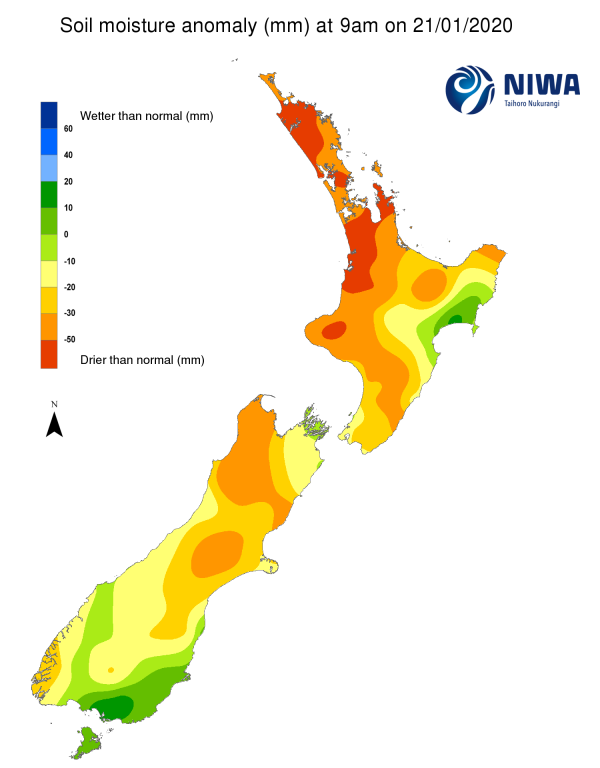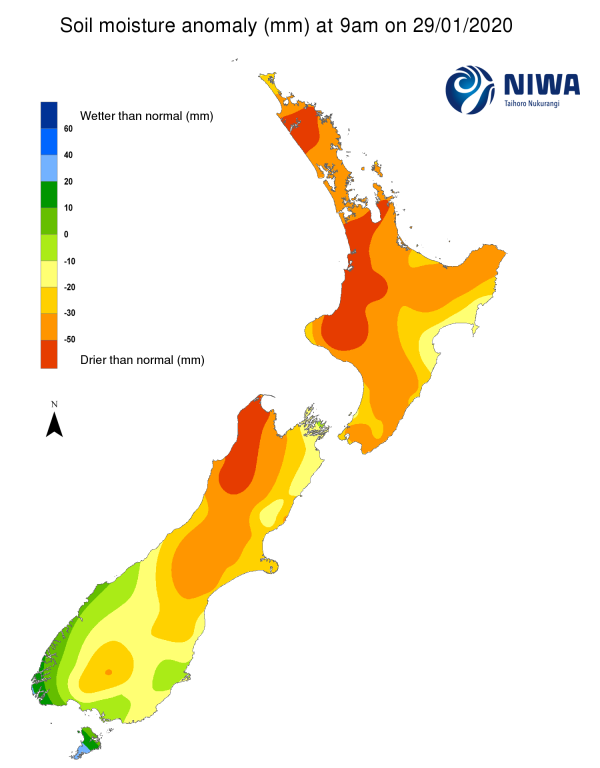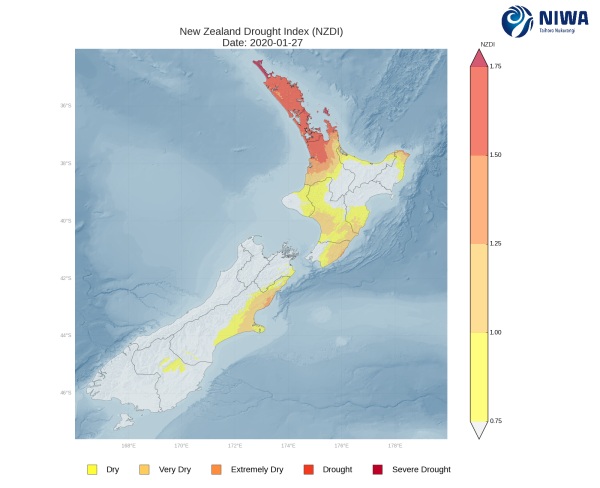A weekly update describing soil moisture patterns across the country to show where dry to extremely dry conditions are occurring or imminent. Regions experiencing significant soil moisture deficits are deemed “hotspots”. Persistent hotspot regions have the potential to develop into drought.
Facts: Soil Moisture
Across the North Island, most locations received little rain during the past week (generally less than 5 mm), leading to further drying of soils across the entire island. The driest soils across the North Island, when compared to normal for this time of the year, are found across parts of Northland and northern and western Waikato, as well as interior Taranaki. There are currently no areas in the North Island where near normal or above normal soil moisture levels are found. In addition, the New Zealand Drought Index (NZDI) shows that the upper North Island (northern Waikato northbound) has widespread meteorological drought conditions, and in fact, the Aupouri peninsula and pockets of Great Barrier Island have recently reached severe meteorological drought conditions (see map at bottom).
All of the current hotspots expanded in the past week. A very large hotspot continues to cover all of Northland, Auckland, northern and western Waikato, and the Coromandel Peninsula. Additional hotspots are in place across most of Wairarapa, East Cape, central Manawatu-Whanganui to Taranaki, and isolated parts of Bay of Plenty.
For the South Island, little rainfall (generally less than 5 mm) was observed across the eastern and far northern South Island during the past week, leading to further soil moisture decreases. The largest decreases occurred across the Tasman Region. However, due to some beneficial rainfall in Fiordland and the West Coast, some soil moisture improvements were observed in those areas. The driest soils in the South Island compared to normal for this time of the year are located across Tasman and interior Buller District. Meanwhile, the wettest soils for this time of the year are found on southern Steward Island.
Many of the hotspots continued to expand during the past week. Current hotspots are now covering much of Hurunui District south to the Waimate District, along with eastern Marlborough, Nelson and nearby parts of Tasman.
Outlook and Soil Moisture
In the North Island, very dry conditions will continue during the next week and rainfall is expected to be well below normal. However, a weakening front may bring some showers mainly to the west and south on Tuesday (4 February), with isolated rainfall totals up to 20 mm possible. For the remainder of the island, weekly rainfall totals will be meagre, generally 5 mm or less.
With minimal rainfall expected in much of the North Island, widespread soil moisture decreases are expected to continue in the next week. Most existing hotspots are anticipated to intensify and expand. In addition, temperatures are expected to be above or well above average in the coming days, this will lead to further soil moisture loss through additional evapotranspiration.
In the South Island, there is a threat for heavy rainfall in western areas in the upcoming week with weekly rainfall totals potentially exceeding 500 mm. Some locations in Fiordland and the West Coast may receive its monthly normal rainfall as fronts are set to impact the area on Sunday-Tuesday (2-4 February). Meanwhile, rainfall totals may exceed 50 mm in Southland, Otago, southern Canterbury and western Tasman. Elsewhere, lower rainfall totals are expected across Nelson, Marlborough, and northern Canterbury, with many locations receiving less than 10 mm.
Heavy rainfall in Fiordland and West Coast region will lead to rapid soil moisture increases in the next week, with increases also expected across Southland, Otago, southern Canterbury and western Tasman.
However, soil moisture levels are expected to remain constant or only experience minor improvements elsewhere. Current hotspots in northern Canterbury, Nelson, and Tasman are expected to strengthen and expand in the next week.
Background:
Hotspot Watch: a weekly advisory service for New Zealand media. It provides soil moisture and precipitation measurements around the country to help assess whether extremely dry conditions are imminent.
Soil moisture deficit: the amount of water needed to bring the soil moisture content back to field capacity, which is the maximum amount of water the soil can hold.
Soil moisture anomaly: the difference between the historical normal soil moisture deficit (or surplus) for a given time of year and actual soil moisture deficits.
Definitions: “Extremely” and “severely” dry soils are based on a combination of the current soil moisture status and the difference from normal soil moisture (see soil moisture maps)
Hotspot: A hotspot is declared if soils are "severely drier than normal" which occurs when Soil Moisture Deficit (SMD) is less than -110 mm AND the Soil Moisture Anomaly is less than -20 mm.
Pictured above: Soil Moisture Anomaly Maps, relative to this time of year. The maps show soil moisture anomaly for the past two weeks.
New Zealand Drought Index (NZDI)
As of 27 January, the New Zealand Drought Index (NZDI) map shows that the upper North Island (northern Waikato northbound) has widespread meteorological drought conditions and the Aupouri peninsula and pockets of Great Barrier Island have in the past week reached severe meteorological drought conditions (see map at bottom). Meteorological drought coverage is expected to increase in these regions due to dry weather in the next week.
Please note: some hotspots in the text above may not correspond with the NZDI map. This difference exists because the NZDI uses additional dryness indices, including one which integrates the rainfall deficit over the past 60 days. Changes are therefore slower to appear in the NZDI compared to soil moisture anomaly maps that are instantaneously updated.



